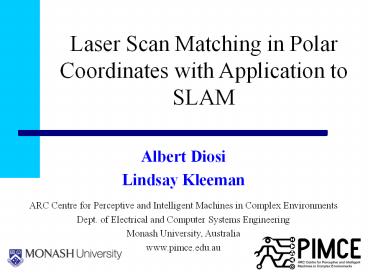Laser Scan Matching in Polar Coordinates with Application to SLAM - PowerPoint PPT Presentation
Title:
Laser Scan Matching in Polar Coordinates with Application to SLAM
Description:
ARC Centre for Perceptive and Intelligent Machines in Complex ... Occlusion handled by over-writing further ranges. Points are occluded by nearer. scan points. ... – PowerPoint PPT presentation
Number of Views:281
Avg rating:3.0/5.0
Title: Laser Scan Matching in Polar Coordinates with Application to SLAM
1
Laser Scan Matching in Polar Coordinates with
Application to SLAM
- Albert Diosi
- Lindsay Kleeman
- ARC Centre for Perceptive and Intelligent
Machines in Complex Environments - Dept. of Electrical and Computer Systems
Engineering - Monash University, Australia
- www.pimce.edu.au
2
Overview
- New 2D laser scan match method presented.
- Polar Scan Matching (PSM) point to point scan
match approach in polar coords. - Avoids searching for point correspondences by
simply matching bearing. - Faster than Iterated Closest Point (ICP) method.
- SLAM implementation demonstrated with PSM.
3
Previous Work
- Scan matching can be categorized by the
association method - Feature to feature,
- eg line segments Gutman PhD 2000 or range
extrema Lingemann et al IROS 2004 - Point to feature.
- Eg Cox IEEE RA 1991
- Point to point.
- Least dependent on environment and chosen here.
4
Point to Point Literature
- Iterative Closest Point (ICP)
- Besl and McKay IEEE PAMI 1992
- Iterative Matching Range Point (IMRP)
- Lu and Milios JIRS 1997
- Iterative Dual Correpondence (IDC)
- Uses IMRP for rotation and ICP for translation in
each iteration Lu and Milios JIRS 1997. - One iteration required if associations known.
- Requires 15-20 iterations in practice since
correct associations are initially unknown.
5
Associations are the Key!
- IDC needs to associate each point in the new scan
with one in the reference scan. - Each point can require all points in other scan
to be checked gt O(n2) computation. - In practice some search restrictions can reduce
this computation. - Polar Scan Matching (PSM) in this paper just
needs to check the same angle of a transformed
scan.
6
Polar Scan Matching
- PSM has these steps
- Scan Preprocessing
- Scan Projection
- Translation Estimation
- Orientation Estimation
- Error Covariance Estimation
7
PSM Preprocessing
- Points not suitable for matching are removed by
median filtering - Chair and peoples legs
- Mixed pixels caused by range discontinuities
- Maximum range measurements (ie no object) removed
by thresholding
8
- Segmentation of objects
- Interpolation between distinct objects avoided
- Possibility of tracking and deleting moving
objects between successive scans. - New segment when consecutive difference gt 20 cm
- Same segment when 3 measurements on nearly same
polar line.
9
Raw Scan Example
10
Preprocessed Scan
11
Scan Projection
- Transform current scan into reference scan frame.
Current scan transformed To reference frame
Reference scan origin
12
Scan Projection (contd)
13
Translation Estimation
- Aim is to find new that minimises
- Association of ranges trivial just use the
bearing. - Linearized regression used over a few iterations
see paper for details.
Sigmoid weight that favourssmall errors
Dudek2000
current projected
reference
14
Orientation Estimation
- Change of orientation is simply a shift in polar
coords. - The shift with min absolute average range error
chosen. - Parabolic interpolation applied to find sub angle
sample estimate using 3 samples centred on min.
15
Error behaviour simulated data
Scan initial mismatch
16
Error Estimation
- If correct associations are known, error
covariance can be estimated from the linear
regression analysis. - In practice this covariance is optimistic since
inevitable errors of association and moving
objects cause larger errors. - Heuristic diagonal covariance used based on
average range residual except in corridors. - Corridors are identified by the variance of
orientations of lines segments lt threshold. - Non-diagonal covariance used for corridors.
17
Corridor Drift
- Corridor environments tend to cause biased
matches
18
Ground Truth Experiments
- Various positions and orientations of a laser
template were marked on a sheet. - Measurements from known relative positions of the
sheet were taken of different environments using
Sick LMS 200 - Displacements of 80 cm and up to 27
19
Ground truth experiments
20
Ground truth matches PSM
21
Ground truth matches ICP
22
PSM Error Behaviour
X error o Y error Angle error
Note corridor scene fails to converge
23
ICP Error behaviour
X error o Y error Angle error
Note corridor scene fails to converge
24
Regions of Convergence
o no convergence o incorrect convergence
point true shift point
PSM
ICP
25
Areas of Convergence
- Averaged over 10 scenes with initial 12º offset
- Convergence defined as within 10 cm and 2º of
true position - PSM converged from 2.99 m2
- ICP converged from 2.80 m2
26
SLAM Implementation
27
SLAM
- EKF based SLAM implemented similar to
Bosse,Newman,Leonard Teller IJRR2004 - Laser scans are used as landmarks.
- New scans stored every 1 m of robot and SLAM
updated every 1 m or 15º - Scan matching acts as a landmark measurement.
- Odometry used over short distances.
28
Polar Scan Matching SLAM
29
Iterative Closest Point (ICP) SLAM
30
Polar Scan Matching SLAM Video (2 min)
- Average scan match time during SLAM on a Celeron
900 MHz laptop was - ICP 65 matches successful at 12.6 msec each.
- PSM 100 matches successful at 3.1 msec each.
31
Conclusions and Future Work
- Presented a new scan match method that works in
native Polar coordinates called Polar Scan
Matching code will be made available on www
see paper. - Removal of occluding points simply done based on
further range. - PSM 4 times faster than ICP.
- PSM SLAM successfully demonstrated.
32
Future Work
- Comparison of PSM with IDC and other scan
matching approaches. - Tracking and removal of moving segments to
improve robustness. - Funding of the ARC Centre for Perceptive and
Intelligent Machines in Complex Environments is
acknowledged.































